#this is an extremely important update from kui
Text
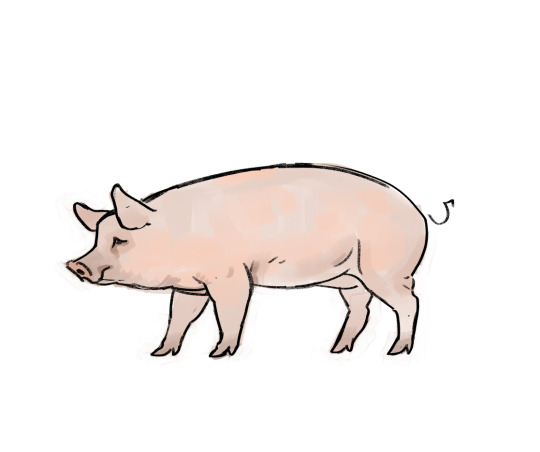
#ryoko kui#dungeon meshi#delicious in dungeon#meshi#MR PIG#this is an extremely important update from kui
183 notes
·
View notes
Text
Top 7 Seven Fighting Games For Android
These days people love to play games. The popularity of playing games on android devices is very high amongst all age of people. There are many genre games available on android devices. In this article, we will be talking about the top 7 best fighting games in 2021. The fighting games genre is no more amongst the most popular genre games anymore, but there are still a lot of people who love to play fighting games. On Android devices, there are not many splendid fighting games options available, but we tried our best to choose the top 7 most amazing fighting games for you so you can play and enjoy these games without trouble.
So here are the top 7 best amazing fighting games for android:
1. Call Of Duty
Call of Duty Mobile (also known as Legends of War) is the first installment of the 'Call of Duty' saga that attempts to transfer the PC and game console gaming experience to Android smartphones. In other words, just like Modern Warfare or Black Ops, this is a multiplayer FPS in every sense of the word.
Controls in Call of Duty Mobile of War are perfectly adapted to touchscreen devices. Use your left thumb to control your character's movements and your right thumb to aim. Double-tapping on the right side of the screen gives you access to a viewpoint system to check your scope. And, just like in many other Android games, your weapon shoots automatically.
Call of Duty Mobile of War includes two main game modes: 'zombies' and 'multiplayer'. Both are popular modes of the franchise as they challenge you to face other online players, as well as collaborate with them hand in hand to take down the undead. Nuketown, Hijacked or Killhouse are just a few of the most popular maps there for you to enjoy.
Call of Duty Mobile of War is an outstanding game that offers you a multiplayer FPS experience for Android. The game also includes extraordinary visuals, a bunch of maps and weapons and the charisma that's become so popular of the Call of Duty franchise.
2. Fatal Fury Special
Fatal Fury Special game is very popular game amongst every age of people. This game is an arcade port. Fatal fury special game series is big in the 1990s but now it’s on mobile devices. Fatal fury special game contains retro graphics, a group of 16 characters, and many more. This game is based on fatal fury 2. You can update this game with a certain time limit. There is also a new combo system. You can play this game with multiplayer. There is no in-app purchase with this game.
3. Twilight Struggle
You might be familiar with a board game version of the game. Twilight Struggle is extremely fun game, all about the tumultuous years of the Cold War. You can learn about the key events of the historic era as you try to keep the different parties satisfied and prevent nuclear Armageddon. The game has been transferred on mobile quite well. However, due to the interface it does look best on an Android tablet rather than a smartphone.
The game can be downloaded after a one-off payment. You can make further in-app purchases as well but these are not necessary for a good gaming experience.
4. Shadow Fight 3
Shadow Fight 3 is the latest entry in the silky-smooth fighting series for Android and is a huge step up in quality. That's saying something because Shadow Fight 2 was pretty incredible in its own right.
Whereas the second game had a 2D art style where you controlled a silhouette shadow fighter, Shadow Fight 3 delivers 3D-rendered arenas packed with a surprising amount of detail. Your fighters have emerged from the shadows, so to speak, and look great.
Shadow Fight has always had buttery-smooth controls and animation and those return here. The physics are spot-on, too — a well-timed heavy attack with a sword can make your enemy drop their sword and send them flying. There's a full campaign to play through and a ton of weapons, armor, and special attacks to unlock and customize your fighter with. There's no multiplayer here, except for playing other people's AI-controlled characters, but the focus on delivering outstanding graphics and smooth gameplay pays off.
Best of all, this game is free, although there's an in-game currency that you'll need to buy new weapons and other upgrades, along with in-app purchases available if you need an influx of coins.
5. Fighting Tiger
Fighting Tiger is a really fun fighting game, despite looking like it came right out of the late 90s/early 00s (especially with its title). The story is weak and dated, but it's not all that important. You're here to practice your kung-fu on bad guys, and you can do that here.
If you care about the story, you're trying to escape your gang, but they aren't going to let you go. It's up to you to survive and save your girlfriend. It's not bad for a game of this caliber.
You can pick up a variety of items — swords, guns, motorcycle helmets, etc — as you go head-to-head with multiple opponents. Combos and choosing the right fighting style are the name of the game here and you'll be doing it a lot as you fight off the bad guys. It's just good, mindless fun.
6. Skullgirls
Skullgirls is something different. It's a fighting game, but it's also an RPG. I say it's a fighting game with RPG elements, but others might argue the opposite. Regardless, Skullgirls is a super cool game. You collect new characters, build them up, and send them into battle to earn victory.
It's an over-the-top game, even as far as fighting games go. The art style is amazing and I absolutely love the character design, animations, and backgrounds. The sound effects are also fantastic and they really draw you into the battles.
Online PvP is only OK, but you don't have to engage in it to enjoy the game. There are plenty of modes to choose from, including a story mode, and you're bound to stay entertained for quite some time. There are in-app purchases, though, asking you to buy relics to summon new characters and coins to level up your characters.
7. Final Fighter
Final Fighter gives off some strong old school fighting game vibes and as someone who was raised on Tekken, that's a serious plus. You could easily go so far as to say that a number of characters in the game are blatant rip-offs from other franchises (Sgt. Kane is clearly Jack-2 from Tekken, Kui is obviously Sakura from Street Fighter, etc), but that's honestly part of the game's charm.
This classically-styled fighting game has some darn good graphics, and characters' moves have a nice amount of impact backing them up. Controls are intuitive, which is saying something for a mobile fighter, and the range of common commands like grabs, low, mid, and high punches and kicks, and special moves are all accounted for here. To execute commands, you've got a virtual analog stick on the left side, which allows you to move forward, back, crouch, and jump, and then you've got a few virtual controls on the right side for heavy and light attacks that you can string together with to form devastating combos.
This is an online game that requires a network connection to function, but you have a number of cool modes to play through, ranging from classic arcade, to 1v1 online matches, all the way to 3v3 team matches! Final Fighter is free with ads and in-app purchases, so add this one to your list if you're on the hunt for your next fighting game fix.
#art#my writing#writers on tumblr#writing#gameblog#tumblr#lovewriting#like for follow#android games#tumblrpost#tumblrgirl#aesthetic#likeforlikes#text post
6 notes
·
View notes
Text
INTERVIEW: Lodoss Creator Ryo Mizuno Discusses Inspirations and Bringing Record of Grancrest War to Mobile
Ryo Mizuno is a legend in the realm of fantasy anime, from his work on seminal classic Record of Lodoss War to his return to those themes in Record of Grancrest War. The latter recently came to life in the form of mobile hack-and-slash action game Record of Grancrest War: Quartet Conflict, and we had the opportunity to speak with both Ryo Mizuno and one of the game's producers, Yurika Tsukita, about the project. Dive in below for a closer look at Mizuno's inspirations, the Lodoss-Grancrest connection, and what it takes to bring his wide-eyed fantasy concepts to the world of video games.
***
The spirit of Record of Lodoss War lives on in Record of Grancrest War, and your works along these lines have attracted a ton of attention for decades now. What is it about Lodoss and related material that keeps you inspired and motivated to create?
Ryo Mizuno: In the end, I enjoy writing about how, in extreme situations like war, people push themselves to their mental and physical limits in order to uphold their principles and achieve their goals. In reality, it unfortunately seems like most wars happen for more base reasons, but in fiction, the story really comes to life when different characters with different end goals and viewpoints can only resolve their differences by clashing on the battlefield. I don't actually give that much thought to who's right or wrong; I simply write about how they are forced to fight because of their differences and how that resolve pushes both parties to do their best to win on the battlefield. I feel these are the kinds of stories that especially need to be written during times of peace.
For Lodoss fans who have yet to dip into Grancrest War, can you elaborate on how the two are connected despite being set in different worlds? Are there grander connections beyond the RPG roots of Lodoss and the RPG sourcebook for Grancrest War?
They may not be connected in terms of worldview, but Record of Grancrest War is designed to allow for easy tie-ins with all sorts of other worlds and that definitely includes Lodoss.
I did also plan both Grancrest and Lodoss's worlds to be easily adaptable for tabletop RPGs, so in that sense they may well have that in common, but of course their systems and settings are quite different. That said, unlike my other works, Grancrest's world is explicitly designed to enable crossovers, so official collaborations can certainly happen that way.
What is the secret ingredient for capturing the unique feel of a tabletop role-playing campaign in the form of anime series like Lodoss War and Grancrest War?
I think it has to do with not overtly leading the viewer down the path of the scenarios I've come up with too much. In tabletop games, game masters come up with a variety of different situations for their players and it's the actions the players take in response to those situations that move the story forward. When running a game, you don't want to lead players by the nose down the story you've already prepared. It's more fun for all involved if you only lay down some ground rules so they don't disruptively exceed the bounds of the game, but otherwise let them run around freely and do what they want within those bounds, meeting them halfway with the story.
How involved were you in the development of Record of Grancrest War: Quartet Conflict? Did you pen original scenarios for the game?
No, I let other people handle that, so I only saw the finished product. When it was done, I tried it out and enjoyed it. *laughs* I did pass on some requests I had for things I wanted to see afterwards, though.
Back when Record of Lodoss War was originally created, documenting and adapting a tabletop role-playing session was a novel concept. Today there are podcasts, video series, and many other examples of turning these RPGs into a narrative experience for an audience. How do you think you would have approached the Lodoss material differently today?
Well, videos are really big right now, so if I were my younger self in this day and age, I think I'd try to become a YouTuber or even a virtual one. Virtual YouTubers can still use their natural voice, which makes for really interesting results. I think it's especially well suited to replays.
You're one of the undisputed kings of fantasy anime. What are some of the essential fantasy stories—whether it's in the form of books, movies, games, or tabletop RPGs—that inspire you?
The Lord of the Rings. Even more so than the actual story, it's the world it describes. I've re-read its dictionary countless times; I always appreciate and enjoy how much detail went into its setting.
For science fiction, I enjoy Dune and I generally like works with a firmly established worldview. In Japan, I've been impressed by the Locke the Superman comic and really any work with a long-running history of its universe.
Of course, when you get to something like Perry Rhodan, there are far too many examples to list, but again, in terms of world-building I enjoy works with detailed settings; it's the kind of style I aspire to in my own writing.
For the producers of Quartet Conflict, can you tell us a little about the process of taking Mizuno-san's series and turning it into an action-RPG? What did you find was most important when attempting to capture the spirit of Grancrest War?
Yurika Tsukita: I feel like the highly detailed characters are really the heart of this work. They all think and act in their own ways, just like real people, and they express themselves accordingly. So for the game, we're focused on highlighting each character's individuality and also pay special attention to their skills. We're also working on scenarios that delve deeper into the characters, which I hope players will enjoy as an opportunity to better get to know and like them.
Can you elaborate on the game's ongoing Faction War and how it will develop over the course of the game?
Guild battles take place every weekend and offer some really nice rewards based on how much players contribute and how well their faction does. I hope they lead to teams coming together and fighting some really intense battles against each other. Players can also get better and bigger rewards as they get stronger and contribute more. We're planning to add more maps and rules to guilds as time goes on, so I hope the players look forward to that.
Are there other regular updates players can look forward to after the game launches?
We're planning to add special login bonuses and expand the game, so I hope that players are excited about its release.
This is for both Mizuno-san and Tsukita-san: Beyond the obvious choice of Record of Grancrest War, are there any other recent anime or manga series you keep up with?
Mizuno: When it comes to properties available overseas, I've enjoyed things like Land of the Lustrous. That one works both as fantasy and as its own unique world. For comics, I thought Delicious in Dungeon was really interesting. To me, it felt nostalgic, like Wizardry's world coming to life as a manga. In recent chapters, it's been going its own, darker way and I can tell it's doing so intentionally. Ms. Kui, the writer, had never really written anything dark before, so I'm excited to see where she takes it from here.
Tsukita: I've been keeping up with the new SWORD ART ONLINE anime series, Alicization, along with JoJo's Bizarre Adventure: Golden Wind. Manga-wise, I love Weekly Shonen Jump and never miss an issue, but I'm currently really into Demon Slayer: Kimetsu no Yaiba. That one has an anime starting in January and I can't wait to check it out.
***
I'd like to thank Mizuno-san, Tsukita-san, and the fine folks at Bandai Namco Entertainment for setting up this interview! If you're at Anime NYC this weekend, they have a few activities you can check out, including an interactive photo booth—with the option to choose between Union or Alliance-themed photo frames—prize giveaways, game kiosks featuring Quartet Conflict, and an in-game promotion that offers up rewards for players who log in between 11/16 and 12/25.
-------
Joseph Luster is the Games and Web editor at Otaku USA Magazine. You can read his webcomic, BIG DUMB FIGHTING IDIOTS at subhumanzoids. Follow him on Twitter @Moldilox.
1 note
·
View note
Text
Kobayashi’s Maid Dragon Episode 5 Notes

Miso soup has extremely strong associations with home and family in Japan. It’s a staple of breakfast and dinner tables, especially when paired with rice (which is common, to say the least), and is a very traditional dish with a long history.
It’s such a big deal, even, that the question “I want to eat the miso soup you make every day,” is a stereotypically Japanese marriage proposal.
When I say “stereotypically Japanese,” I mean that Japanese people see it that way. The Japanese language and culture tend to be pretty “indirect” compared to others (particularly English, which everyone in Japan spends years in school studying), and people in Japan are very aware of this. A common example given in schools is the famous translation by Natsume Souseki, where he translated the phrase “I love you” in an English text to “The moon is beautiful, isn’t it?” in Japanese.
Anyway there’s some context for this scene, and in particular the choice of miso soup as the dish Kobayashi commented on.

You’ll notice they have at least four umbrellas there. It’s easy for those cheap vinyl ones to pile up when you have to do a bunch of walking (even just to/from the train station); you can’t just keep one in the car, and if it starts raining on a day you didn’t bring one...
By the way, in case you were thinking “four for three people isn’t that many though,” she had a different four in episode one, even before Tohru showed up:

Also: man, that before&after. Good for you Kobayashi ;_;

She says “aitsura あいつら” here, meaning they not she; basically Kanna, at least, is being included here.

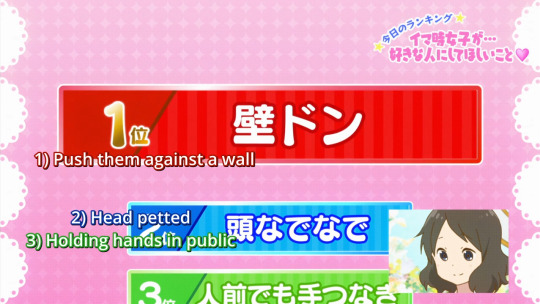

These shows totally exist, they look exactly like this, and they literally have done this topic. In fact, this specific topic is a common one, with the list being updated every so often. “Wide show” is actually the name of this type of show, a subset of the infamous “variety show.”
Number one is “Kabe-don” (kabe = wall, and don = sound effect for like “slam/bang”). Originally the word was (and still is) used to refer to when people in the next room over would bang on the wall to politely inform you that you’re being too fucking loud it’s after midnight already god damn.
In the past few years though, the word caught on as a meme, referring to a common situation that pops up in shoujo manga a lot, where the(/a) love interest would do this:

to the heroine. This specific usage of the term was seemingly coined by voice actress Shintani Ryoko (Sae from Hidamari Sketch) in 2008, while she was trying to explain the act on a radio show when discussion “moe situations”.
Kabe-don’s popularity seems to have died down some lately though (since honestly it’s pretty awkward irl).
The others are pretty self-explanatory I think, though it’s perhaps worth pointing out that yes, these are all things you actually can find on these lists. If “holding hands in public” sounds way too normal/basic to be on one to you, well, welcome to Japan.
(To be fair it’s not like super rare or anything, just not as common as you’d expect in many other countries and kind of considered a little embarrassing, particularly for men.)
Another semi-recently popular one of these “moe whatevers” is ago-kui 顎クイ, basically “chin tug/pull”, where the kui-er grabs the kui-ee’s chin to pull their face closer or whatever (often as a precursor to a kiss, for example). It’s a common pair with the kabe-don.
Basically the takeaway here is that Japan’s been making memes real since way before 2016 came along.


The word for “pursue love” here is kyuuai 求愛, which is probably most commonly used when referring to the mating calls/rituals of animals (as seen by how Tohru likens the audience/panel squeals to bird cries). You can use it with people too, but it’s not exactly very conversational language.

Lol.
Also yeah “Tatsumi 辰巳” has that dragon zodiac kanji in it again. By the by, while there’s no Tatsumi-cho in Tokyo, there is just a “Tatsumi.” It’s by Tokyo Bay, within walking distance of Comiket-host Big Sight and the life-sized Gundam statue, and roughly where a lot of March Comes in Like a Lion is set.
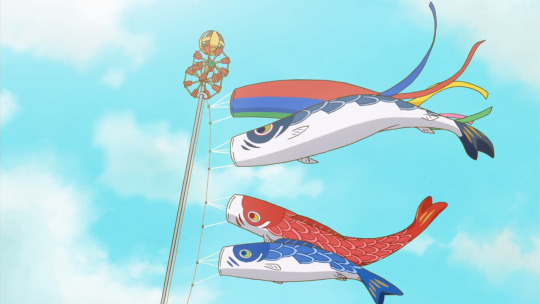
These fish flags/wind socks (they’re koi, trying to climb the waterfall and become dragons, i.e. Magikarp) are traditionally put up on Children’s Day, May fifth. Yet another way Kyoani uses these establishing shots to tell you what season it is and invoke certain associations.

You’ll see this “48 ___ skills/techniques” thing a fair bit in Japanese media; it’s a reference to the 48 Killer Techniques of Kinnikuman/Ultimate Muscle (I think that’s as far back as the reference goes, anyway).
Yes, the name of the store in the background has one of the dragon kanji in it’s name (the lower portion of 籠, 龍).

Yeah this is what most Japanese office workplaces look like; open office plans. It’s kind of stressful having no privacy like that, but it does make it easier to ask people stuff I guess.

The “proper” version of this word is sumimasen すみません, basically meaning sorry/excuse me. What he says is saasen サーセン, a rather colloquial version of it. It kind of goes like: sumimasen → suimasen → sunmasen → saasen.
This sort of thing is quite common in Japanese, especially when there’s a set way you’re supposed to say something (as is common) that has a lot of syllables. Another example you might hear is arigatou gozaimashita being shortened down to azashita, typically at a convenience store or something, from an employee who’s busy with something else and just saying it because they have to.
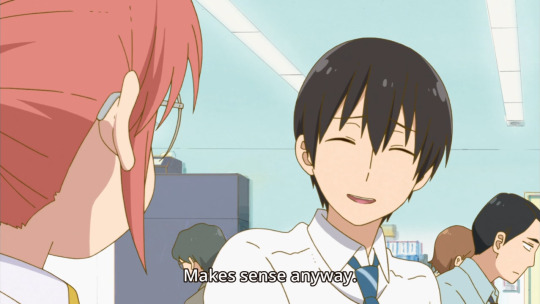
What he says here is shou ga nai しょうがない. If you’ve ever picked up on how often “can’t be helped” or similar seems to be said in anime...this is what that is. It’s an incredibly common phrase in Japan, not just in anime but irl as well. It literally means that there’s nothing that can be done, and can be used in a broad swath of situations. It’s actually fairly similar to “oh well” in a number of cases.
Like above, it has several variations depending on how formal/informal you want it: shikata arimasen, shiyou ga nai, shou ga nai, shaanai, etc. etc.

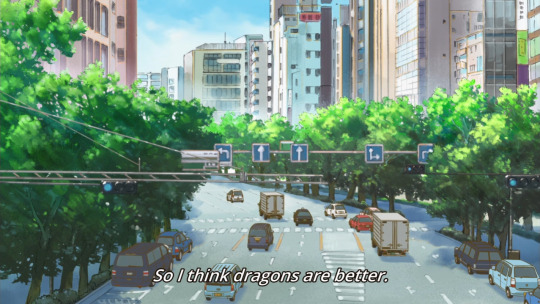
Very minor nuance point, but she says she thinks dragons are superior (~が上, are “above”). “I think dragons are better” sounds, to me, more like indicating preference (”I like dragons better”), whereas the Japanese line has more of an observational tint to it (”Dragons appear to be superior”).
Again, minor and arguable point, but if I didn’t like to be pedantic I wouldn’t be writing these things.

Similar situation as the above, but I would say this is referring specifically to Kobayashi; more “she hasn’t noticed, has she?” than “no one.”

This is actual code, you can find it in places like here.

I like how the lint roller seems to have pink hair on it.
Also, just to restate, this is totally a Japanese everyworkplace and it is kind of giving me flashbacks.
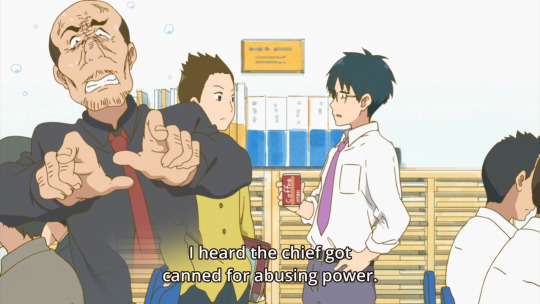
The word for “abusing power” here is pawahara パワハラ, short for power harassment, another Japanese English-ism. It’s often paired with sexual harassment (sekuhara セクハラ) when discussing abuse in the workplace, and both are illegal. A common and particularly serious example of it is forcing people to work unpaid overtime at the threat of being fired.

Another nuance thing, but Saikawa here is not so much asking Kanna to draw her, but more expressing surprise, like “Wait you’re willing to draw me?”
Saikawa (才川)’s name, by the way, sounds like “the cutest” (最カワ). If you’ve heard of the Saimoe contests, it sounds like that but the kawa from kawaii instead of moe, a common sort of abbreviation.

Hmmm, I wonder what this could mean...

Ah.


You’re supposed to offer a drink to visitors in Japan, both to your home or to your office (like people from another company there for a meeting). I imagine that’s not exactly unique to Japan by any stretch, but as a custom it’s given more weight than in many others. A question of degree, I guess.
I’m sure there’s some reasoning behind the change in drinks from hot tea to orange-whatever, but who knows what. My guess is that it’s (possibly among other things) another way to show that the seasons are changing; it was cold the first time he came, so a hot drink, and warmer the second, so a cold drink. (Not to say there was a long time skip between the two necessarily, but of course the weather can change on a dime in spring, chilly one day and surprisingly hot the next.)
The way he phrases this, o-tenami haiken to ikou ka お手並み拝見と行こうか。is some pretty fancy language. Nothing much to say about it specifically that the translation doesn’t convey, but just a general note that Fafnir regularly uses less conversational language than the rest of the cast (as you might expect from his demeanor) in ways the subs don’t necessarily make clear.
As an inverse example, this line from earlier:

“Shall we go home?” sounds sorta fancy, but the Japanese line, just “kaerokka 帰ろっか,” is casual as fuck.
This is one of those things that can be difficult when translating Japanese to English, as Japanese has many different ways of saying literally just the same word but with different levels of formality, where in English you have to come up with different ways to phrase it to try and capture both the meaning and the formality level. Possible, but often time-consuming.
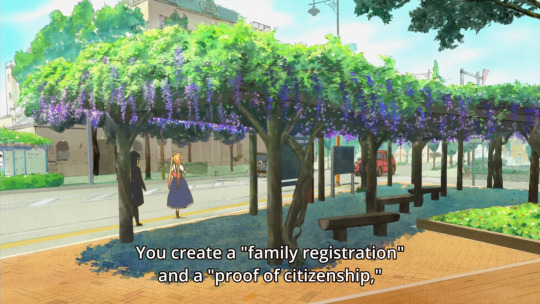

A family registration, koseki 戸籍, refers to document proving, basically, your family tree. When the government, way back when, was deciding how to administer the population, they figured it would be easier to group people into family units and have the family choose a head of household that would both represent them and have responsibility for them.
So they created this family registry system, where everyone* is registered as a member of a family. The “head of household” thing isn’t so important anymore, but the registry still fulfils the role of birth/death certificates, keeps track of marriages/divorces/adoptions, is proof of citizenship, and is effectively a constantly-updated census.
There can only be one family name per koseki, so it’s impossible to get married and not change your last name (unless you happen to have the same last name already); one of the two must join the other’s koseki and take on that name.
*Everyone, who is a citizen that is. Foreigners who marry a Japanese citizen are listed on the registry, but are not officially part of it.
Note that you usually don’t actually need this necessarily to rent an apartment irl. Usually a juumin-hyou 住民票 covers it.
“But wait,” you ask, “why does it say proof of citizenship in the sub when she says juumin-hyou, if the koseki is the proof of citizenship and the family registration?” as I put several words in your confused and increasingly angry mouth.
Well, probably because either the translator wasn’t familiar with these minor details and isn’t paid enough to look them up, or they felt that would make more sense to the average viewer.
A juumin-hyou 住民票 is actually a certificate of residency. It keeps track of your address and various other personal details (immediate family, social security number equivalent, birthdate, etc.). This one foreigners can get, assuming they have a proper visa, and is the one you’ll need to do most things like opening a bank account or signing a lease agreement.
Note that this thing means you’re required to fill out paperwork at city hall whenever you move, so they can keep it updated with your correct address.
A “personal seal” is a little stamp with your name, which is used like a signature would be in many other countries (i.e., for signing contracts and such). Make sure it doesn’t get stolen!
Often, people will have three of these that each have different levels of authority. The “real” one (jitsu-in 実印), for contract signing, must be registered with the government so they can prove it’s really yours. The “bank” one (ginkou-in 銀行印), registered with the bank upon opening a bank account (can be the same as the jitsu-in if you want it to be). And the “Amazon delivery” one (mitome-in or nin-in 認印), which isn’t registered officially anywhere, and is probably most often used nowadays when “signing” for a package delivery.
Of course, Tohru just magicked all of these into existence, because she can do that. Augh.

I know Fafnir. I know.


The kanji for Ooyama (大山) mean “big mountain,” and the kanji for Takeshi (猛) means basically “ferocious.”
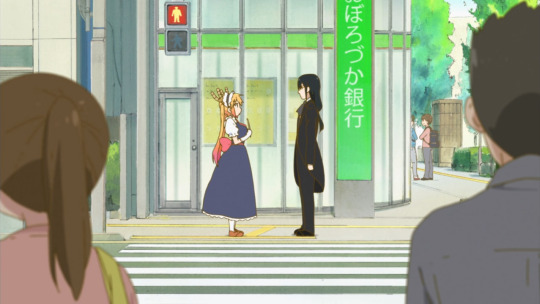
The building in the background here is a bank!

The building in the background here is a business that dispatches staff to support elderly people who can’t fully live on their own!

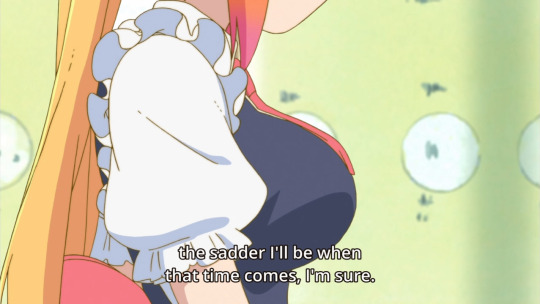
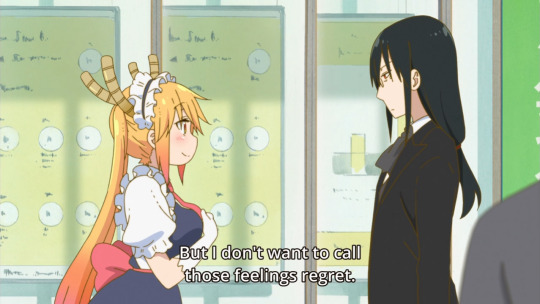
Another fairly minor point, but here she’s saying “I don’t think I’d call those feelings ‘regret’.” not “I don’t want to [...].” (だけど私はその気持ちを後悔とは呼ばないと思います). Not a big difference, but possibly an important one depending on how deeply you care to read into things.
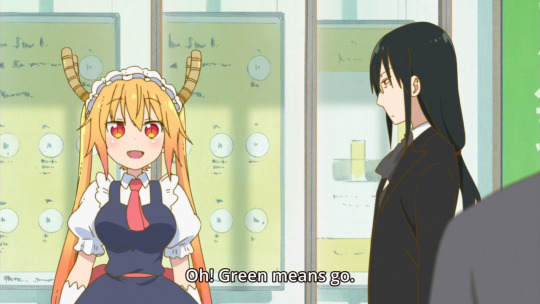
The word here for “green,” ao 青, usually means “blue.” And in fact sometimes the “green” traffic lights in Japan actually are blue. However, up until relatively recently, the “ao” color word actually covered both blue and green (now midori 緑 is the usual word for “green”). This relative lack of distinction between blue and green is actually common in many languages.
As a random anecdote, a Japanese acquaintance of mine who was living in America once got pulled over for running a red light. Though their English was very good, they still got mixed up and kept trying to tell the police officer “I’m sorry I thought the light was blue,” which made for a very awkward talk.
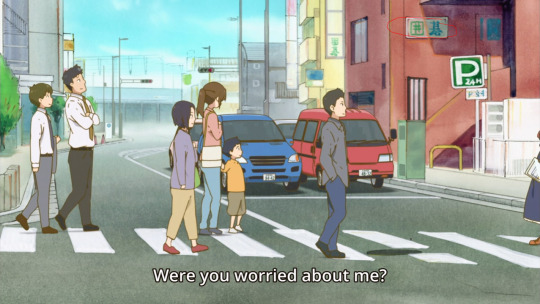
This sign means Go. The game, not the verb. You know, this one.


The kanji for “money” (kane 金) is also the kanji for gold (usually “kin”).

Tadpole is another spring season word.
Probably unrelated, but one Japanese variant of the saying “like father like son” is “the child of a frog is a frog.”

The word for “psychic powers” (such as ESP) in Japanese is basically “super abilities.”

And the word for “magic trick” (at least, the one used here) is tenjina 手品, more like “hand trick” (in a literal sense, anyway). Magic trick is a perfectly good translation, but since they were just talking about how it wasn’t magic and clearly don’t know what a “magic trick” is, I just wanted to give some context as to why that line sounds less off(?) in the Japanese.

Like in the last episode with cute/kawaii, Kanna says “kami” the first time and “god (goddo)” the second. You...probably noticed that, but yeah.

"To enter [into] your hand” (te ni ireru/hairu 手に入れる/入る) is an idiom that means to get/gain/obtain. Like in a Zelda game or something when you open a treasure chest and get an item, this is the phrase used. Or when someone is elected to a high office, they’ve “te ni ireru’d” themselves some political power.
It’s a super common phrase, such that...and I hesitate to say this...I actually don’t think it was an intended pun(!). As in, I don’t think a native speaker would recognize that it was supposed to be one, even if it was intentional. It’s the kind of joke that’d be so painful you’d have a bunch of people gnashing their teeth about it online, and I haven’t been able to find any of that.

The word here is detarame でたらめ, which is closer to something like bunk, bullshit, nonsense, etc. “Fiction” feels a little too kind.

As mentioned in episode one, the kanji for waterfall (滝), minus the water radical (氵), is a kanji for dragon (竜). Conveniently, the water radical is cut off quite cleanly by the edge of the screen. What a strange coincidence.

Their clothes both say “dragon,” just Tohru’s has the kanji for it (ryuu 竜) and Kanna’s has it in hiragana (ryuu りゅう), which is cuter/more childish.

Lol that they bought spoons just to practice with despite being able to easily fix broken ones with magic anyway.

Yet another small nuance thing, but Kobayashi’s line leans more toward a sort of “it’s alright if you just do the things only you can do.” Again, minor and arguable, but it’s the difference between saying it’s okay to do something versus saying you should do something. (original: トールにしか出来ないことをすればいいんだよ)

Lunches in elementary school are eaten in the classroom, and typically served (as seen) by the students themselves; whoever’s on duty. The meals themselves are made by professionals, of course, and tend to be pretty healthy.

The “magic” she says here is actually the English word magic (majikku, rather), which in conversation is more likely to refer to magic tricks (similar to tejina above) than actual magic (which would generally be some variant of the Japanese word for it, mahou 魔法).

The stereotypical “hypnotism” item to swing in front of people in Japan is a 5 yen coin attached to string, rather than a watch. 5 yen coins have a hole in the middle, so it’s easy to tie a string to. Plus, they have a cultural connection to sort of supernatural stuff already; they’re a favorite for making donations at shrines and such because “five yen” (五円) is pronounced “go-en,” which is the same as a word for basically “fate” (ご縁).

Episode One Notes
Episode Two Notes
Episode Three Notes
Episode Four Notes
52 notes
·
View notes